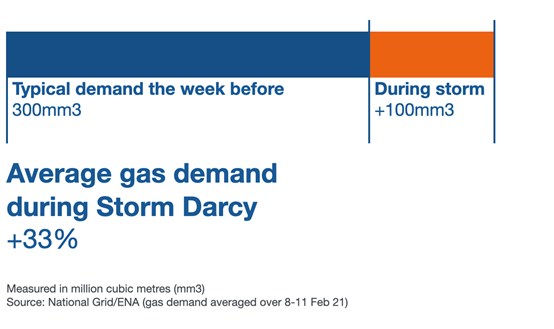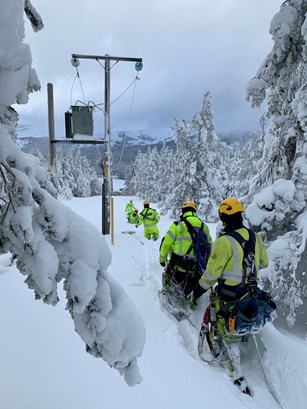Gas demand increased by a third during the most recent cold snap, but the UK's energy networks maintained safe and reliable energy supplies throughout.
As the snow came down and temperatures plummeted during Storm Darcy, the UK’s electricity and gas network operators can now reflect on a strong effort keeping energy flowing to homes, businesses, and communities across the country.
During the cold spell, temperatures fell nationwide compared with the preceding week. The gas pipes and electricity cables that stretch right across the country – from John O’Groats to Land’s End – rose to the challenge, keeping homes warm, lights on and Britain’s businesses running.
Unsurprisingly, national demand for gas increased by around a third. The week before Storm Darcy, an average winter period, saw a daily demand for gas at around 300 million cubic metres. This increased by a third as the cold weather struck.
Although this was similar to 2018’s Beast from the East which saw similar levels of demand, the bad weather in 2018 lasted a week or so longer. Despite this exceptional level of demand, the reliability of the local gas networks remained at 99.9%.
Meanwhile the electricity network faced its own challenges. The snow and cold weather meant that it might be possible for overhead power lines to break.
Local electricity network operators were well prepared. They had made decisions that ensured readiness and allowed them to respond to what was happening in their operating areas. This included putting additional staff on standby and ensuring that their fleets, which included specialist vehicles, were ready to be deployed.
David Smith, Chief Executive of Energy Networks Association which represents the UK and Ireland’s energy networks businesses said:
“Even though demand for gas soared by a third as people looked to heat their homes, the networks responded very well which is a result of the dedication of the frontline teams as well as strategic planning. I am very grateful to all those who have been out working in very challenging conditions to keep energy flowing for customers all across the UK.”
Press contacts for journalists
Peter Kocen
Senior Press and Public Affairs Manager
+44 (0)7792 220 974
peter.kocen@energynetworks.org
ENA Press Office
Notes to editor
Photo credit: Scottish and Southern Electricity Networks line workers in Ballater, Scotland (Feb 2021)
Gas demand during Storm Darcy:
- Monday 8 Feb: 393m cubic metres per day
- Tuesday 9 Feb: 402m cubic metres per day
- Wednesday 10 Feb: 414m cubic metres per day
- Thursday 11 Feb: 405m cubic metres per day
Source: National Grid / ENA
About Energy Networks Association
Energy Networks Association (ENA) is the industry body representing the electricity wires, gas pipes and energy system in the UK and Ireland.
ENA helps its members meet the challenge of delivering electricity and gas to communities across the UK and Ireland safely, sustainably and reliably.
Its members include every major electricity and gas network operator in the UK and Ireland, independent operators, National Grid ESO which operates the electricity system in Great Britain and National Gas which operates the gas system in Great Britain. Its affiliate membership also includes companies with an interest in energy, including Heathrow Airport and Network Rail.
What are energy network operators?
Energy network operators manage and maintain the wires, pipes and other infrastructure which delivers electricity and gas to your home, business and community. They are private companies which are regulated by Ofgem and employ around 40,000 people in Great Britain.






